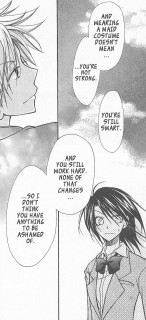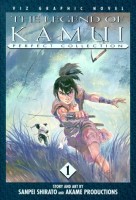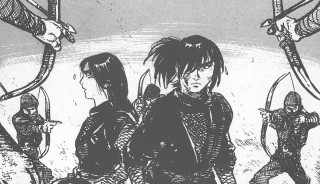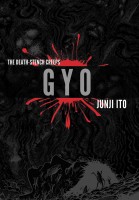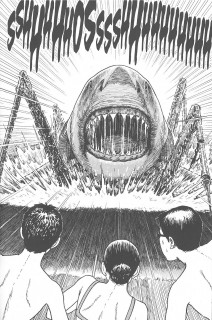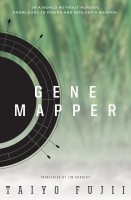 Creator: Hirohiko Araki
Creator: Hirohiko Araki
U.S. publisher: Viz Media
ISBN: 9781421578804
Released: May 2015
Original release: 1988
For years the only part of Hirohiko Araki’s epic and fashionably strange shōnen manga series JoJo’s Bizarre Adventure that was available in English was the third story arc, Stardust Crusaders. A standalone side story, Rohan at the Louvre was released as well, but it wasn’t until 2015 that the very beginning of the series, Phantom Blood, was translated and released in print, and in a lovely hardcover edition, too. (I have a feeling that the popularity of the recent JoJo’s Bizarre Adventure anime adaptation probably had something to do with that.) Phantom Blood was originally published in five volumes in Japan between 1987 and 1988, but in 2002 the first story arc was re-released in three volumes. Viz Media’s English-language edition is based on that 2002 release. JoJo’s Bizarre Adventure, Part 1: Phantom Blood, Volume 2, published in 2015, collects part of the second volume, all of the third volume, and part of the fourth volume of the original Japanese release.
JoJo’s life isn’t exactly turning out the way that he would have hoped or expected. His father lays dying in his arms after having taken a fatal blow that was intended for him. Behind the knife that will end his father’s life is Dio, a man who was raised as his brother but who has turned against the Joestar family as was always his plan and intention. Not only that, Dio has gained untold powers from a mysterious and ancient stone mask. Now a vampire, Dio is nearly immortal and possesses great strength. Even he doesn’t know the full extent of his astonishing abilities, but he has already begun gathering followers who are drawn to his charisma and promises of power. With the help of a curious man named Baron Zeppeli, JoJo becomes one of the only people who might have a chance of defeating Dio. Zeppeli unlocks JoJo’s own latent talents, training him in Sendo and its use of Hamon energy, an impressive martial technique which when mastered may make it possible for JoJo to destroy Dio and save the world.
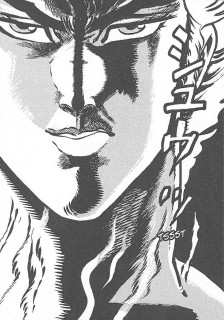 JoJo’s Bizarre Adventure is a very aptly named series. It is an exceedingly strange manga with nonstop, over-the-top action and drama. Nearly every phrase of narration and dialogue in Phantom Blood, Volume 2 is an exclamation. Even the few relatively quiet moments are fervently intense and the calm never lasts for very long. Most of the second volume of Phantom Blood consists of extended fight scenes and training sequences. Araki keeps Phantom Blood moving along at a breakneck pace which sometimes includes the actual breaking of necks. Blood, gore, dismembered body parts, splattered guts, eyeballs, and brain matter are all fairly common in the series. There is definitely a strong element of horror in the early part of JoJo’s Bizarre Adventure. While Araki’s artwork in Phantom Blood understandably doesn’t show the same refinement found in his later illustrations, it still has a sense of visceral dynamism and the occasional panel can actually be quite beautiful or striking.
JoJo’s Bizarre Adventure is a very aptly named series. It is an exceedingly strange manga with nonstop, over-the-top action and drama. Nearly every phrase of narration and dialogue in Phantom Blood, Volume 2 is an exclamation. Even the few relatively quiet moments are fervently intense and the calm never lasts for very long. Most of the second volume of Phantom Blood consists of extended fight scenes and training sequences. Araki keeps Phantom Blood moving along at a breakneck pace which sometimes includes the actual breaking of necks. Blood, gore, dismembered body parts, splattered guts, eyeballs, and brain matter are all fairly common in the series. There is definitely a strong element of horror in the early part of JoJo’s Bizarre Adventure. While Araki’s artwork in Phantom Blood understandably doesn’t show the same refinement found in his later illustrations, it still has a sense of visceral dynamism and the occasional panel can actually be quite beautiful or striking.
JoJo’s Bizarre Adventure is a very odd manga. The story, artwork, and characters are all memorable if for no other reason than they are so over-the-top and strange. Additionally, Araki freely mixes historical events with historical fantasy in Phantom Blood. For example, Jack the Ripper becomes one of Dio’s earliest followers and England’s bloody dynastic struggles of the sixteenth century form a dramatic backstory for some of the other warriors that JoJo must face as he pursues his adoptive brother. Plenty of Phantom Blood is completely Araki’s own creation, though. And lest there be any confusion about all the weirdness, JoJo’s faithful and at times even useful companion Speedwagon is there to explain everything that’s going on, as well as to narrate the obvious. Speedwagon’s help isn’t needed to realize how much of a villain Dio is, though. Even before becoming a vampire Dio delighted in his own evil and the evil of others, but with his newfound powers he is in a better position than ever to make his malevolent schemes a reality. How successful he will actually be remains to be seen, but so far the results are marvelously terrifying and outrageous.


